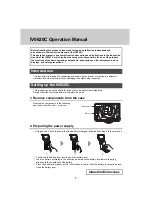
man_digiflex_com_en_02_5.doc
33
Set to the desired unit of measurement (2nd; Menu; Menu Units),
select a measuring range according to the length of the cable to be
tested, set the pulse velocity to the desired option (NVP,
v
/
2
in m/µs or
ft/µs), set the display mode to ”DUAL ”. The sockets of the instrument
are the zero mark of the cursor. Use the marker to subtract the
supplied interconnect line.
(5) Use keys (
v
/
2
) and the rotary encoder to set the cable-specific
propagation time to the value specific value of the cable to be tested.
(6) Match the
Digiflex Com
to the object under test as described in
section 3.7.
(7) First of all, try to find the (open) end of the cable.
(8) Look for a fault reflection in the overview trace displayed on top. In
doing so, increase gain or amplitude correction steadily until the point
of fault is clearly visible.
Fig 6. Display
(9) Use the cursor to move the section marker (black bar between the two
traces) such that the reflection is located above the bar. Then use the
rotary encoder to move the cursor in the lower part of the screen to the
place where the foot point of the fault is located (see Fig. 6).
(10) The distance to the fault can now be read off directly. This value can
be indicated in meters, feet, or nanoseconds depending on the setting
in menu Units. The reflectogram can be saved in a the memory for
documentation purposes .
(11) Press
to switch the
Digiflex Com
off after the test has been
completed.
Summary of Contents for Digiflex Com
Page 2: ...2 man_digiflex_com_en_02_5 doc...
Page 3: ...man_digiflex_com_en_02_5 doc 3 Digiflex Com compact and light weight Time Domain Reflectometer...
Page 4: ...4 man_digiflex_com_en_02_5 doc...
Page 8: ...8 man_digiflex_com_en_02_5 doc...
Page 44: ...44 man_digiflex_com_en_02_5 doc...
















































